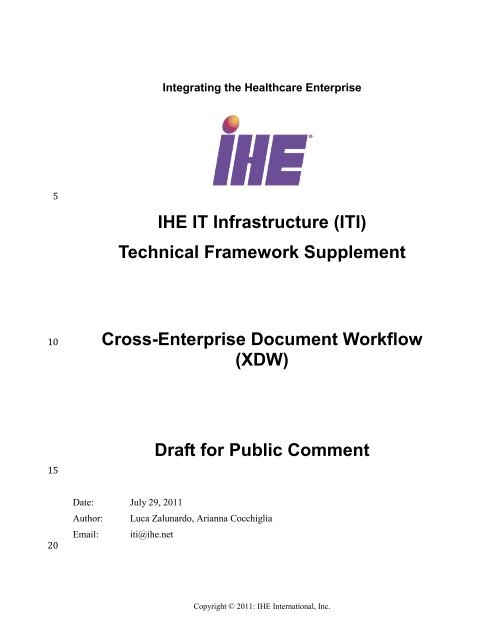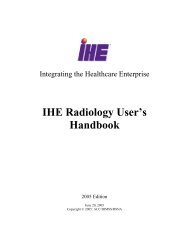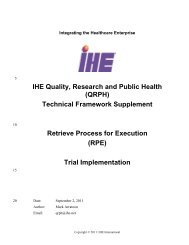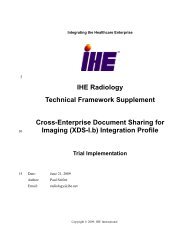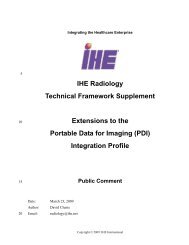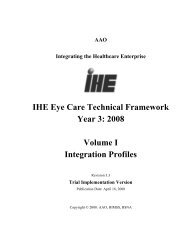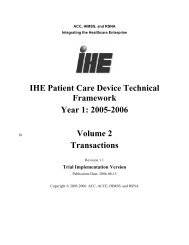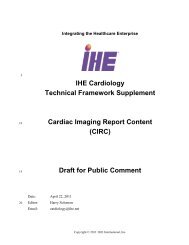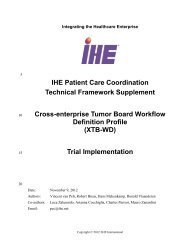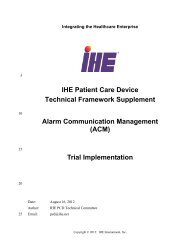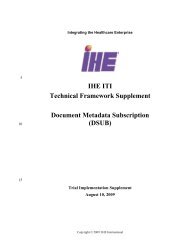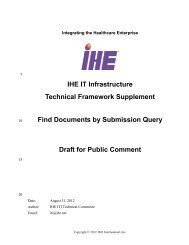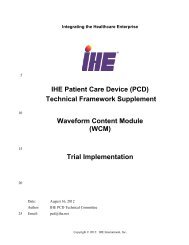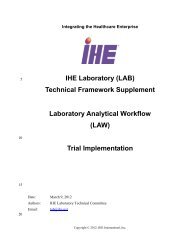XDW - IHE
XDW - IHE
XDW - IHE
You also want an ePaper? Increase the reach of your titles
YUMPU automatically turns print PDFs into web optimized ePapers that Google loves.
Integrating the Healthcare Enterprise<br />
5<br />
<strong>IHE</strong> IT Infrastructure (ITI)<br />
Technical Framework Supplement<br />
10<br />
Cross-Enterprise Document Workflow<br />
(<strong>XDW</strong>)<br />
15<br />
Draft for Public Comment<br />
20<br />
Date: July 29, 2011<br />
Author: Luca Zalunardo, Arianna Cocchiglia<br />
Email: iti@ihe.net<br />
Copyright © 2011: <strong>IHE</strong> International, Inc.
<strong>IHE</strong> IT Infrastructure Technical Framework Supplement – Cross-Enterprise Document<br />
Workflow (<strong>XDW</strong>)<br />
______________________________________________________________________________<br />
25<br />
30<br />
35<br />
Foreword<br />
This is a supplement to the <strong>IHE</strong> IT Infrastructure Technical Framework 7.0. Each supplement<br />
undergoes a process of public comment and trial implementation before being incorporated into<br />
the volumes of the Technical Frameworks.<br />
This supplement is submitted for Public Comment between June 29, 2011 and August 26, 2011.<br />
Comments are invited and may be submitted at http://www.ihe.net/iti/iticomments.cfm. In order<br />
to be considered in development of the Trial Implementation version of the supplement<br />
comments must be received by August 26, 2011.<br />
This supplement describes changes to the existing technical framework documents and where<br />
indicated amends text by addition (bold underline) or removal (bold strikethrough), as well as<br />
addition of large new sections introduced by editor’s instructions to “add new text” or similar,<br />
which for readability are not bolded or underlined.<br />
“Boxed” instructions like the sample below indicate to the Volume Editor how to integrate the<br />
relevant section(s) into the relevant Technical Framework volume:<br />
Replace Section X.X by the following:<br />
40<br />
45<br />
General information about <strong>IHE</strong> can be found at: www.ihe.net<br />
Information about the <strong>IHE</strong> IT Infrastructure can be found at:<br />
http://www.ihe.net/Domains/index.cfm<br />
Information about the structure of <strong>IHE</strong> Technical Frameworks and Supplements can be found at:<br />
http://www.ihe.net/About/process.cfm and http://www.ihe.net/profiles/index.cfm<br />
The current version of the <strong>IHE</strong> Technical Framework can be found at:<br />
http://www.ihe.net/Technical_Framework/index.cfm<br />
___________________________________________________________________________<br />
2<br />
Rev. 2.0 – 2011-07-29<br />
Copyright © 2011: <strong>IHE</strong> International, Inc.
<strong>IHE</strong> IT Infrastructure Technical Framework Supplement – Cross-Enterprise Document<br />
Workflow (<strong>XDW</strong>)<br />
______________________________________________________________________________<br />
CONTENTS<br />
50<br />
55<br />
60<br />
65<br />
70<br />
75<br />
80<br />
85<br />
90<br />
INTRODUCTION ....................................................................................................................................................... 5<br />
OPEN ISSUES AND QUESTIONS ................................................................................................................................... 6<br />
CLOSED ISSUES.......................................................................................................................................................... 6<br />
VOLUME 1 – INTEGRATION PROFILES ............................................................................................................ 9<br />
1.7 HISTORY OF ANNUAL CHANGES .......................................................................................................................... 9<br />
1.N COPYRIGHT PERMISSION ..................................................................................................................................... 9<br />
2.2.X Cross-Enterprise Document Workflow Content Profile ........................................................................... 10<br />
X CROSS-ENTERPRISE DOCUMENT WORKFLOW CONTENT PROFILE ............................................... 10<br />
X.1 ACTORS/ TRANSACTIONS .................................................................................................................................. 12<br />
X.2 CROSS-ENTERPRISE DOCUMENT WORKFLOW PROFILE OPTIONS ...................................................................... 12<br />
X.2.1 View Option .............................................................................................................................................. 12<br />
X.2.2 Document Import Option .......................................................................................................................... 12<br />
X.3 <strong>XDW</strong> ACTOR GROUPING AND PROFILE INTERACTIONS .................................................................................... 13<br />
X.4 <strong>XDW</strong> PROCESS FLOW ....................................................................................................................................... 14<br />
X.4.1 <strong>XDW</strong> Approach to Workflow .................................................................................................................... 14<br />
X.4.1.1 <strong>XDW</strong> Workflow Architecture ............................................................................................................................ 14<br />
X.4.1.2 <strong>XDW</strong> Document Structure ................................................................................................................................. 15<br />
X.4.2 <strong>XDW</strong> Use-Cases and Process Flow in an XDS Affinity Domain .............................................................. 17<br />
X.4.2.1 Referral Workflow Use Case .............................................................................................................................. 17<br />
X.4.2.1.1 Referral Workflow Use Case - Step by Step .............................................................................................. 18<br />
X.5 <strong>XDW</strong> SECURITY CONSIDERATIONS .................................................................................................................. 22<br />
VOLUME 3 – CROSS-TRANSACTION SPECIFICATIONS AND CONTENT SPECIFICATION ............... 23<br />
5.4 <strong>XDW</strong> WORKFLOW CONTENT MODULE .......................................................................................................... 23<br />
5.4.1 Referenced Standards ............................................................................................................................... 23<br />
5.4.2 Discussion of Content Standards .............................................................................................................. 23<br />
5.4.2.1 <strong>XDW</strong> Workflow Document Elements from HL7 CDA Standard ....................................................................... 26<br />
5.4.2.2 <strong>XDW</strong> Workflow Document Elements defined by <strong>IHE</strong>_<strong>XDW</strong>Profile ................................................................. 26<br />
5.4.2.3 <strong>XDW</strong> Workflow Document Elements from the OASIS Human Task................................................................. 26<br />
5.4.2.4 Relationship between Task and ...................................................................................................... 27<br />
5.4.3 Content Specification ................................................................................................................................ 29<br />
5.4.4 Complete Example .................................................................................................................................... 35<br />
5.4.5 Workflow Document Management ............................................................................................................ 35<br />
5.4.5.1 Workflow Document Lifecycle Management ..................................................................................................... 35<br />
5.4.5.2 Associations Types and Folder ............................................................................................................................ 36<br />
5.4.5.3 Create workflow .................................................................................................................................................. 36<br />
5.4.5.4 Update Workflow Document .............................................................................................................................. 36<br />
5.4.5.5 Association of a clinical document to a task and ............................................................................ 37<br />
5.4.5.6 Get the Workflow Document and a clinical document associated to the workflow ............................................ 37<br />
5.4.5.7 Use of the eventCodeList to manage the status of a Workflow Document ......................................................... 37<br />
5.4.5.8 Parameters for Required Queries ......................................................................................................................... 38<br />
5.4.6 XDS Metadata ........................................................................................................................................... 39<br />
5.4.6.1 Document Metadata ............................................................................................................................................ 39<br />
5.4.6.2 XDS SubmissionSet Metadata ............................................................................................................................ 40<br />
5.4.6.3 XDS Folder Metadata .......................................................................................................................................... 40<br />
5.4.6.3.1 XDSDocumentEntry.formatCode ............................................................................................................... 41<br />
___________________________________________________________________________<br />
3<br />
Rev. 2.0 – 2011-07-29<br />
Copyright © 2011: <strong>IHE</strong> International, Inc.
<strong>IHE</strong> IT Infrastructure Technical Framework Supplement – Cross-Enterprise Document<br />
Workflow (<strong>XDW</strong>)<br />
______________________________________________________________________________<br />
95<br />
100<br />
APPENDIX X BASIC UNSTRUCTURED WORKFLOW DEFINITION EXAMPLE ..................................... 41<br />
X.1 WORKFLOW DEFINITION IDENTIFIER ................................................................................................................. 41<br />
X.2 WORKFLOW DEFINITION IDENTIFIER ................................................................................................................. 42<br />
X.3 WORKFLOW OPENING AND CLOSING ................................................................................................................. 42<br />
X.4 TASKS DESCRIPTIONS ........................................................................................................................................ 42<br />
X.4.1 Task type “born completed” ..................................................................................................................... 42<br />
X.4.2 Task type “two states task” ...................................................................................................................... 42<br />
___________________________________________________________________________<br />
4<br />
Rev. 2.0 – 2011-07-29<br />
Copyright © 2011: <strong>IHE</strong> International, Inc.
<strong>IHE</strong> IT Infrastructure Technical Framework Supplement – Cross-Enterprise Document<br />
Workflow (<strong>XDW</strong>)<br />
______________________________________________________________________________<br />
105<br />
110<br />
115<br />
120<br />
125<br />
130<br />
135<br />
Introduction<br />
The Cross-Enterprise Document Workflow (<strong>XDW</strong>) profile enables participants in a multiorganizational<br />
environment to manage and track the tasks related to patient-centric workflows as<br />
the systems hosting workflow management applications coordinate their activities for the health<br />
professionals they support. <strong>XDW</strong> builds upon the sharing of health documents provided by other<br />
<strong>IHE</strong> profiles such as XDS, adding the means to associate documents conveying clinical facts to a<br />
patient-specific workflow. <strong>XDW</strong> provides a common interoperability infrastructure upon which<br />
a wide range of specific workflow definitions may be supported. It is designed to support the<br />
complexity of health services delivery with flexibility to adapt as workflows evolve.<br />
This profile defines a shared workflow state via a management and tracking data structure, called<br />
a “Workflow Document”, that records the creation of tasks and maintains a historical record of<br />
tasks as they move through the associated workflow. The Workflow Document also maintains<br />
the references to health information input and output associated with each task. Such shared<br />
workflow status information allows the various participating systems to coordinate by:<br />
• being aware of the history of a workflow for a patient;<br />
• obtaining and reading the workflow’s incomplete tasks;<br />
• updating this shared document as the workflow tasks are performed according to a<br />
referenced workflow definition.<br />
<strong>XDW</strong> is intended to offer a common, workflow-independent interoperability infrastructure that:<br />
1. Provides a platform upon which a wide range of specific workflows can be defined<br />
with minimal specification and implementation efforts on the workflow definition (e.g.,<br />
Medical Referrals Workflow, Prescriptions Workflow, Home Care Workflow).<br />
2. Benefits many clinical and non-clinical domains by avoiding different competing<br />
approaches to workflow management.<br />
3. Increases the consistency of workflow interoperability, and enables the development of<br />
interoperable workflow management applications where workflow-specific<br />
customization is minimized<br />
4. Facilitates the integration of multi-organizational workflows with the variety of existing<br />
workflow management systems used within the participating organizations.<br />
5. Offers the necessary flexibility to support a large variety of different healthcare<br />
workflows by not being overly constrained.<br />
More specifically <strong>XDW</strong> supports workflows that are:<br />
• patient-centric.<br />
• Based on business/clinical needs that are defined externally to the <strong>XDW</strong> Profile. Such<br />
workflow definitions have to be known only by the applications within the participating<br />
systems, not by the <strong>XDW</strong> infrastructure (flexibility).<br />
• Executed in loosely connected, distributed environments, where centralized workflow<br />
management systems are not desired, or in many instances, possible.<br />
___________________________________________________________________________<br />
5<br />
Rev. 2.0 – 2011-07-29<br />
Copyright © 2011: <strong>IHE</strong> International, Inc.
<strong>IHE</strong> IT Infrastructure Technical Framework Supplement – Cross-Enterprise Document<br />
Workflow (<strong>XDW</strong>)<br />
______________________________________________________________________________<br />
140<br />
The <strong>XDW</strong> Document illustration shows how an <strong>XDW</strong> Document supporting a Workflow<br />
Definition is exchanged between “edge” applications using Document Sharing infrastructure.<br />
Figure X-1. <strong>XDW</strong> Workflow Architecture<br />
145<br />
Open Issues and Questions<br />
150<br />
155<br />
160<br />
Closed Issues<br />
1. Should there be any clinical information inside the Workflow Document No, <strong>XDW</strong> as<br />
specified requires that all the Clinical information be included by reference to external<br />
documents. (Figure 1). This ensures that a generic Workflow Document structure is<br />
defined, with only a few attributes customized for the workflow specifics (e.g., workflow<br />
definition IDs, workflow description, task codes, task description, possible referenced<br />
documents specification, etc.). (introduce a block which has the information of the<br />
Workflow Document, such an header, with title, purpose, creator, UniqueID for workflow<br />
instance …).<br />
2. It was decided to not include the management of the status of the task that are “booked<br />
task in the future”. Steps are a record of past up the most recent steps that has been<br />
performed. Future activities should be introduced inside documents referenced as<br />
outputs (e.g. orders, requests, treatment plans, etc.). This reflects the reality that in a<br />
multi-organizational environment future steps are an “expectation” shared by one<br />
professional with others that will rely upon their medical judgment and the latest<br />
information to perform or not such expected activities within the constraints of the<br />
workflow description”.<br />
3. The same document can be referenced in the input or output of one or more task<br />
___________________________________________________________________________<br />
6<br />
Rev. 2.0 – 2011-07-29<br />
Copyright © 2011: <strong>IHE</strong> International, Inc.
<strong>IHE</strong> IT Infrastructure Technical Framework Supplement – Cross-Enterprise Document<br />
Workflow (<strong>XDW</strong>)<br />
______________________________________________________________________________<br />
165<br />
170<br />
175<br />
180<br />
185<br />
190<br />
195<br />
200<br />
4. This profile specifies no rules for controlling the succession of tasks except through the<br />
reference to a workflow definition as specified by the Workflow Document typecode and<br />
description.<br />
5. <strong>IHE</strong>-ITI specifies a classCode for <strong>XDW</strong> Workflow Document.<br />
6. This profile is contestualized with XDS, XDM and XDR; it is let to the future to specify<br />
application of the profile in XCA..<br />
7. Should we be more specific in term of kinds of queries have to be supported or<br />
implemented by a Document Consumer in <strong>XDW</strong> Show all workflow for patient, show me<br />
all active workflow, I’ve a Workflow Document Id give me the approved one (walking<br />
through replace associations or with folder or how)<br />
A section has been added to describe query strategies in Volume 3.<br />
8. A step may refer to another Workflow Document as input or output (created a new<br />
workflow). The capability to have a task refer to another specific task in the same WD as<br />
inputs or outputs has not been included.<br />
9. <strong>XDW</strong> does not explain how to define a notification system about the<br />
change(replacement). Should an appendix be developed to discuss<br />
Because <strong>XDW</strong> relies on the family od XDS family introducing notification mechanism<br />
such as DSUB or NAV or a matter of combining existing profiles. The possibility is<br />
mentioned as a note on the volume 1 use case.<br />
10. In a Workflow Document, the reference to an input or output document in a step is a<br />
documentID. Is it sufficient<br />
<br />
11. Appropriateness of the use of FolderID for referencing other Workflow Documents. (To<br />
reference a Workflow Document inside an other Workflow Document benefits from the<br />
use of the FolderID of the Workflow Document. This avoids referencing a specific<br />
Workflow Document that may have been deprecated due to further steps been added.)<br />
Closed. The use of the folder has be adopted and explained in Volume 3.<br />
12. Appropriateness of the use of Folders for managing back links from documents to<br />
Workflow Documents. Should this back link be mandatory or optional (A performance<br />
improvement mechanism to find the Workflow Documents referencing a specific clinical<br />
document has not been included. An approach to have any referenced documents placed<br />
in the same folder as the Workflow Documents has been considered but not included.<br />
This Folder mechanism could have offered a simpler back-link within an XDS affinity<br />
domain. However it does not scale up to document that may be referenced in a multicommunity<br />
environment (use of XCA) As it is expected that <strong>XDW</strong> would be extended in<br />
the future to multi-communities.)<br />
___________________________________________________________________________<br />
7<br />
Rev. 2.0 – 2011-07-29<br />
Copyright © 2011: <strong>IHE</strong> International, Inc.
<strong>IHE</strong> IT Infrastructure Technical Framework Supplement – Cross-Enterprise Document<br />
Workflow (<strong>XDW</strong>)<br />
______________________________________________________________________________<br />
205<br />
210<br />
215<br />
220<br />
225<br />
230<br />
235<br />
The use of the backlink has been left as an implementation choice, the use of the folder<br />
has been suggested only for the use cases based on an XDS infrastructure.<br />
13. Definition of the information that will be in the header: open/close, creator, uniqueID,<br />
Closed and defined in Volume 3.<br />
14. Management of the closing of a workflow to avoid inactive Workflow Document being<br />
returned by queries. This introduce some form of state of the workflow. However, as<br />
<strong>XDW</strong> does not want to define a mechanisms to define overall workflow states (this may<br />
be done through the definition of specific steps by the workflow specific specifications<br />
built on top of <strong>XDW</strong>. To make that point clear, it is proposed to only introduce a<br />
“workflow active flag”, which may be valued either as: “active” or “inactive” to make<br />
clear that such a mechanism is quite limited. It is proposed to place this “workflow<br />
active flag” in the document metadata “event code list”. It is proposed to not duplicate<br />
this workflow active flag in the workflow document header, but to simply introduce a<br />
copy of the flag indication in the workflow step data that resulted in modifying the<br />
“workflow active flag”.<br />
Agreed.<br />
15. A framework for specifying <strong>XDW</strong>-Based Content Profiles is proposed. It does not allow<br />
the <strong>XDW</strong> Document Content specification to be changed in its structure (no new data<br />
elements may be added). It allows to constrain already defined data elements in the<br />
<strong>XDW</strong> Workflow Document such as defining: (1) a set of Step Name codes and display<br />
names allowed, (2) succession rules/constraints between these steps, (3) the referenced<br />
input and output document content specifications (e.g. <strong>IHE</strong> PCC , Pharmacy, Laboratory,<br />
QRPH Content profiles), (3) the ability to span “sub-workflows” by creating new<br />
Workflow Documents, etc. This approach enables the development of more generic <strong>XDW</strong><br />
Workflow management applications.<br />
A workflow definition for a basic unstructured workflow has been proposed in an<br />
appendix. Later a guide for documenting workflow definition profiles will be developed<br />
as handbook.<br />
16. This proposal uses the CDA as formal structure of the Workflow Document. Is it<br />
appropriate If not propose a detailed alternative.<br />
No. The use of Human task was preferred.<br />
17. This proposal does not yet specify templates, value set if any, codes, etc. these will be<br />
defined, please comment.<br />
A workflow definition for a basic unstructured workflow has been proposed in an<br />
appendix. Later a guide for documenting workflow definition profiles will be developed<br />
as handbook.<br />
___________________________________________________________________________<br />
8<br />
Rev. 2.0 – 2011-07-29<br />
Copyright © 2011: <strong>IHE</strong> International, Inc.
<strong>IHE</strong> IT Infrastructure Technical Framework Supplement – Cross-Enterprise Document<br />
Workflow (<strong>XDW</strong>)<br />
______________________________________________________________________________<br />
Volume 1 – Integration Profiles<br />
240<br />
245<br />
1.7 History of Annual Changes<br />
Add the following bullet to the end of the bullet list in section 1.7<br />
X. Added the <strong>XDW</strong> Profile that enables participants in a multi-organization environment to<br />
track the tasks related to patient-centric workflows as activities are coordinated.<br />
For the information of reviewers, the following permission is already part of the framework.<br />
1.n Copyright Permission<br />
Health Level Seven, Inc., has granted permission to the <strong>IHE</strong> to reproduce tables from the HL7 standard. The HL7<br />
tables in this document are copyrighted by Health Level Seven, Inc.<br />
All right reserved. Material drawn from these documents is credited where used.<br />
250<br />
255<br />
260<br />
265<br />
270<br />
Copyright © OASIS® 2010. All Rights Reserved.<br />
All capitalized terms in the following text have the meanings assigned to them in the OASIS Intellectual Property<br />
Rights Policy (the "OASIS IPR Policy"). The full Policy may be found at the OASIS website.<br />
This document and translations of it may be copied and furnished to others, and derivative works that comment on<br />
or otherwise explain it or assist in its implementation may be prepared, copied, published, and distributed, in whole<br />
or in part, without restriction of any kind, provided that the above copyright notice and this section are included on<br />
all such copies and derivative works. However, this document itself may not be modified in any way, including by<br />
removing the copyright notice or references to OASIS, except as needed for the purpose of developing any document<br />
or deliverable produced by an OASIS Technical Committee (in which case the rules applicable to copyrights, as set<br />
forth in the OASIS IPR Policy, must be followed) or as required to translate it into languages other than English.<br />
The limited permissions granted above are perpetual and will not be revoked by OASIS or its successors or assigns.<br />
This document and the information contained herein is provided on an "AS IS" basis and OASIS DISCLAIMS ALL<br />
WARRANTIES, EXPRESS OR IMPLIED, INCLUDING BUT NOT LIMITED TO ANY WARRANTY THAT THE USE<br />
OF THE INFORMATION HEREIN WILL NOT INFRINGE ANY OWNERSHIP RIGHTS OR ANY IMPLIED<br />
WARRANTIES OF MERCHANTABILITY OR FITNESS FOR A PARTICULAR PURPOSE.<br />
OASIS requests that any OASIS Party or any other party that believes it has patent claims that would necessarily be<br />
infringed by implementations of this OASIS Committee Specification or OASIS Standard, to notify OASIS TC<br />
Administrator and provide an indication of its willingness to grant patent licenses to such patent claims in a manner<br />
consistent with the IPR Mode of the OASIS Technical Committee that produced this specification.<br />
OASIS invites any party to contact the OASIS TC Administrator if it is aware of a claim of ownership of any patent<br />
claims that would necessarily be infringed by implementations of this specification by a patent holder that is not<br />
willing to provide a license to such patent claims in a manner consistent with the IPR Mode of the OASIS Technical<br />
Committee that produced this specification. OASIS may include such claims on its website, but disclaims any<br />
obligation to do so.<br />
OASIS takes no position regarding the validity or scope of any intellectual property or other rights that might be<br />
claimed to pertain to the implementation or use of the technology described in this document or the extent to which<br />
___________________________________________________________________________<br />
9<br />
Rev. 2.0 – 2011-07-29<br />
Copyright © 2011: <strong>IHE</strong> International, Inc.
<strong>IHE</strong> IT Infrastructure Technical Framework Supplement – Cross-Enterprise Document<br />
Workflow (<strong>XDW</strong>)<br />
______________________________________________________________________________<br />
275<br />
280<br />
285<br />
290<br />
295<br />
300<br />
305<br />
310<br />
any license under such rights might or might not be available; neither does it represent that it has made any effort to<br />
identify any such rights. Information on OASIS' procedures with respect to rights in any document or deliverable<br />
produced by an OASIS Technical Committee can be found on the OASIS website. Copies of claims of rights made<br />
available for publication and any assurances of licenses to be made available, or the result of an attempt made to<br />
obtain a general license or permission for the use of such proprietary rights by implementers or users of this OASIS<br />
Committee Specification or OASIS Standard, can be obtained from the OASIS TC Administrator. OASIS makes no<br />
representation that any information or list of intellectual property rights will at any time be complete, or that any<br />
claims in such list are, in fact, Essential Claims.<br />
The name "OASIS" is a trademark of OASIS, the owner and developer of this specification, and should be used only<br />
to refer to the organization and its official outputs. OASIS welcomes reference to, and implementation and use of,<br />
specifications, while reserving the right to enforce its marks against misleading uses. Please see http://www.oasisopen.org/who/trademark.php<br />
for above guidance.<br />
2.2.X Cross-Enterprise Document Workflow Content Profile<br />
The Cross-Enterprise Document Workflow (<strong>XDW</strong>) profile enables participants in a multiorganization<br />
environment to manage and track the steps related to patient-centric workflows as<br />
the systems hosting workflow management applications coordinate their activities for the health<br />
professionals they support. <strong>XDW</strong> builds upon the sharing of health documents provided by other<br />
<strong>IHE</strong> profiles such as XDS, adding the means to associate documents conveying clinical facts to a<br />
patient-specific workflow. <strong>XDW</strong> provides a common interoperability infrastructure upon which<br />
a wide range of specific workflow definitions may be supported. It is designed to support the<br />
complexity of health services delivery with much flexibility to adapt as workflows evolve.<br />
Add Section X<br />
X Cross-Enterprise Document Workflow Content Profile<br />
The Cross-Enterprise Document Workflow (<strong>XDW</strong>) profile enables participants in a multiorganizational<br />
environment to manage and track the tasks related to patient-centric workflows as<br />
the systems hosting workflow management applications coordinate their activities for the health<br />
professionals they support. <strong>XDW</strong> builds upon the sharing of health documents provided by other<br />
<strong>IHE</strong> profiles such as XDS, adding the means to associate documents conveying clinical facts to a<br />
patient-specific workflow. <strong>XDW</strong> provides a common interoperability infrastructure upon which<br />
a wide range of specific workflow definitions may be supported. It is designed to support the<br />
complexity of health services delivery with flexibility to adapt as workflows evolve.<br />
This profile defines a shared workflow state via a management and tracking data structure, called<br />
a “Workflow Document”, that records the creation of tasks and maintains a historical record of<br />
tasks as they move through the associated workflow. The Workflow Document also maintains<br />
the references to health information input and output associated with each task. Such shared<br />
workflow status information allows the various participating systems to coordinate by:<br />
• being aware of the history of a workflow for a patient;<br />
• obtaining and reading the workflow’s incomplete tasks;<br />
• updating this shared document as the workflow tasks are performed according to a<br />
referenced workflow definition.<br />
___________________________________________________________________________<br />
10<br />
Rev. 2.0 – 2011-07-29<br />
Copyright © 2011: <strong>IHE</strong> International, Inc.
<strong>IHE</strong> IT Infrastructure Technical Framework Supplement – Cross-Enterprise Document<br />
Workflow (<strong>XDW</strong>)<br />
______________________________________________________________________________<br />
315<br />
320<br />
325<br />
330<br />
335<br />
<strong>XDW</strong> is intended to offer a common, workflow-independent interoperability infrastructure that:<br />
1. Provides a platform upon which a wide range of specific workflows can be defined<br />
with minimal specification and implementation efforts on the workflow definition (e.g.,<br />
Medical Referrals Workflow, Prescriptions Workflow, Home Care Workflow).<br />
2. Benefits many clinical and non-clinical domains by avoiding different competing<br />
approaches to workflow management.<br />
3. Increases the consistency of workflow interoperability, and enables the development of<br />
interoperable workflow management applications where workflow-specific<br />
customization is minimized<br />
4. Facilitates the integration of multi-organizational workflows with the variety of existing<br />
workflow management systems used within the participating organizations.<br />
5. Offers the necessary flexibility to support a large variety of different healthcare<br />
workflows by not being overly constrained.<br />
More specifically <strong>XDW</strong> supports workflows that are:<br />
• patient-centric.<br />
• Based on business/clinical needs which are defined externally to the <strong>XDW</strong> Profile. Such<br />
workflow definitions have to be known only by the applications within the participating<br />
systems, not by the infrastructure systems.<br />
• Executed in loosely connected, distributed environments, where centralized workflow<br />
management systems are not desired, or in many instances, possible.<br />
Figure X-1 shows how an <strong>XDW</strong> Document supporting a Workflow Definition is exchanged<br />
between “edge” applications using Document Sharing infrastructure.<br />
Figure X-1. <strong>XDW</strong> Workflow Architecture<br />
___________________________________________________________________________<br />
11<br />
Rev. 2.0 – 2011-07-29<br />
Copyright © 2011: <strong>IHE</strong> International, Inc.
<strong>IHE</strong> IT Infrastructure Technical Framework Supplement – Cross-Enterprise Document<br />
Workflow (<strong>XDW</strong>)<br />
______________________________________________________________________________<br />
340<br />
345<br />
350<br />
X.1 Actors/ Transactions<br />
The <strong>XDW</strong> Content Profile is based on three actors, the Content Creator, the Content Consumer<br />
and the Content Updater. Content is created by a Content Creator or a Content Updater and is to<br />
be consumed by a Content Consumer or a Content Updater. The sharing or transmission of<br />
content or updates from one actor to the other is addressed by the use of appropriate <strong>IHE</strong> profiles<br />
described in the section on Content Bindings with XDS, XDM or XDR (See ITI TF-3:5.X.6).<br />
An <strong>XDW</strong> Content Creator shall be able to create new workflows by creating a new <strong>XDW</strong><br />
Workflow Document and placing it into a new folder. A Content Updater shall be able to<br />
contribute to existing workflows by consuming an existing Workflow Document and replacing it<br />
with an updated <strong>XDW</strong> Workflow Document. A Content Consumer may only obtain and read<br />
<strong>XDW</strong> Workflow Content Documents.<br />
Figure X.1-1. <strong>XDW</strong> Actor Diagram<br />
355<br />
X.2 Cross-Enterprise Document Workflow Profile Options<br />
Options that may be selected for this Profile are listed in the table X.2-1 along with the Actors to<br />
which they apply.<br />
Table X.2-1 <strong>XDW</strong> - Actors and Options<br />
Actor Options Vol & Section<br />
Content Creator No options defined - -<br />
Content Consumer View Option ITI TF-1: X.2.1<br />
Document Import Option ITI TF-1: X.2.2<br />
Content Updater View Option ITI TF-1: X.2.1<br />
Document Import Option ITI TF-1: X.2.2<br />
X.2.1 View Option<br />
This option applies to the viewing of the Workflow Document (See PCC TF-2:3.1.1)<br />
360<br />
X.2.2 Document Import Option<br />
This option applies to the import of the Workflow Document (See PCC TF-2:3.1.2)<br />
___________________________________________________________________________<br />
12<br />
Rev. 2.0 – 2011-07-29<br />
Copyright © 2011: <strong>IHE</strong> International, Inc.
<strong>IHE</strong> IT Infrastructure Technical Framework Supplement – Cross-Enterprise Document<br />
Workflow (<strong>XDW</strong>)<br />
______________________________________________________________________________<br />
365<br />
370<br />
375<br />
X.3 <strong>XDW</strong> Actor Grouping and Profile Interactions<br />
A <strong>XDW</strong> Content Creator, Content Updater and Content Consumer shall be grouped with<br />
appropriate actors from the XDS, XDM and XDR profile to exchange <strong>XDW</strong> Workflow<br />
Documents. The metadata used for document entries in document sharing or interchange has<br />
specific relationships or dependencies (which we call bindings, see ITI TF-3:5.X.6) to the<br />
content of the clinical document – a <strong>XDW</strong> Workflow Document.<br />
When <strong>XDW</strong> is used in conjunction with XDS:<br />
• An <strong>XDW</strong> Content Creator shall be grouped with:<br />
o An XDS Document Source with the Folder Management Options<br />
• An <strong>XDW</strong> Content Updater shall be grouped with:<br />
o An XDS Document Source with both the Document Replacement Option and the<br />
Folder Management Options<br />
o An XDS Document Consumer<br />
• An <strong>XDW</strong> Content Consumer shall be grouped with:<br />
o An XDS Document Consumer<br />
380<br />
385<br />
390<br />
When <strong>XDW</strong> is used in conjunction with XDR:<br />
• An <strong>XDW</strong> Content Creator shall be grouped with:<br />
o An XDR Document Source<br />
• An <strong>XDW</strong> Content Updater shall be grouped with:<br />
o An XDR Document Source<br />
o Optionally an XDR Document Recipient<br />
• An <strong>XDW</strong> Content Consumer shall be grouped with:<br />
o An XDR Document Recipient<br />
When <strong>XDW</strong> is used in conjunction with XDM:<br />
• An <strong>XDW</strong> Content Creator shall be grouped with:<br />
o An XDM Portable Media Creator<br />
• An <strong>XDW</strong> Content Updater shall be grouped with:<br />
o An XDM Portable Media Creator<br />
o Optionally an XDM Portable Media Importer<br />
• An <strong>XDW</strong> Content Consumer shall be grouped with:<br />
o An XDM Portable Media Importer<br />
395<br />
Note: The support of Workflow spanning XDS, XDR and XDM environments is not explicitly addressed.<br />
___________________________________________________________________________<br />
13<br />
Rev. 2.0 – 2011-07-29<br />
Copyright © 2011: <strong>IHE</strong> International, Inc.
<strong>IHE</strong> IT Infrastructure Technical Framework Supplement – Cross-Enterprise Document<br />
Workflow (<strong>XDW</strong>)<br />
______________________________________________________________________________<br />
X.4 <strong>XDW</strong> Process Flow<br />
400<br />
405<br />
410<br />
X.4.1 <strong>XDW</strong> Approach to Workflow<br />
<strong>XDW</strong> is a core component of a common, workflow-independent interoperability infrastructure<br />
that provides a platform upon which a wide range of specific workflows can be defined by<br />
“content specialization” with minimal specification and implementation efforts (e.g., Medical<br />
Referrals, Prescriptions, Home Care).<br />
This section first describes the overall architecture within which the <strong>XDW</strong> profile operates.<br />
Next, the structure of the <strong>XDW</strong> workflow document, the primary data structure that is shared<br />
among the workflow participants, is described.<br />
X.4.1.1 <strong>XDW</strong> Workflow Architecture<br />
A Workflow Definition is structured as a set of logical or clinical tasks definitions and rules.<br />
Each task definition describes an activity or a group of activities that need to be accomplished by<br />
the owner of the task. The rules in the workflow definition ensure that the different participants<br />
in a workflow operate jointly to advance within tasks and to move from one task to an other in a<br />
consistent way.<br />
Figure YY presents an overview of the Workflow Architecture built around the <strong>XDW</strong> Profile.<br />
Figure X.4.1.1-1 <strong>XDW</strong> Architecture Overview<br />
415<br />
420<br />
In this workflow architecture:<br />
• The first layer supports the sharing or exchange of documents. This interoperability<br />
foundation is enabled by a set of existing <strong>IHE</strong> document sharing profiles such as XDS,<br />
XDR and XDM along with document content profiles and security/privacy profiles such<br />
as ATNA and (optionally) BPPC.<br />
• The second layer defines a generic data structure called a Workflow Document which is<br />
shared among the workflow participants by using the first layer of this architecture.<br />
___________________________________________________________________________<br />
14<br />
Rev. 2.0 – 2011-07-29<br />
Copyright © 2011: <strong>IHE</strong> International, Inc.
<strong>IHE</strong> IT Infrastructure Technical Framework Supplement – Cross-Enterprise Document<br />
Workflow (<strong>XDW</strong>)<br />
______________________________________________________________________________<br />
425<br />
430<br />
435<br />
440<br />
Likewise, the clinical and administrative documents that are used as input and produced<br />
as output by the tasks of workflows managed by the <strong>XDW</strong> profile are shared using the<br />
same first layer of this architecture.<br />
• The third layer introduces the semantic definition of the workflows that can be<br />
understood and executed among the participating systems/applications. The orchestration<br />
of specific workflows allows the workflow participants to share a common understanding<br />
of the specific tasks, the dependencies between these tasks, and a number of rules that<br />
control the workflow execution.Execution details are conveyed through the <strong>XDW</strong><br />
Workflow Document defined by the second layer of the architecture. The specification<br />
of Workflow Definitions at this third layer is distinct from the <strong>XDW</strong> Profile and is<br />
currently best handled with a natural language expression (See example of Basic<br />
Unstructured Workflow Definition Profile, ITI TF-3:Appendix X).<br />
• The fourth layer of this architecture contains the applications executed by the<br />
participating systems. Such applications bridge between <strong>XDW</strong> managed workflow and<br />
the locally managed workflow. Much of the details of the local workflows managed by<br />
each application will be hidden and encapsulated in “higher” granularity tasks exposed<br />
through <strong>XDW</strong>, as such details would not need to be externally exposed. The workflow<br />
definitions conveyed by the third layer should only contain higher granularity tasks that<br />
require workflow coordination across organizational boundaries.<br />
445<br />
450<br />
455<br />
X.4.1.2 <strong>XDW</strong> Document Structure<br />
The <strong>XDW</strong> Profile uses the <strong>XDW</strong> Workflow Document to manage workflows.<br />
The <strong>XDW</strong> Workflow Document enables participants in a multi-organization environment to<br />
manage and track the execution of patient-centric workflows. The structure of<br />
WorkflowDocument is organized into Tasks and TaskEvents.<br />
A Task describes an activity, or a group of activities, that need to be accomplished or have been<br />
accomplished. A Task is characterized by several attributes:<br />
• the type of task,<br />
• the owner of the task,<br />
• the current status that are valid for this task,<br />
• the references to documents used for input or produced as output<br />
• the history of past Task Events for this task, that document the progress of the task up to<br />
the present state<br />
When a person or organization has been assigned as owner of the task, the task is placed under<br />
execution. (It moves from a “created” or “ready” state to an “in-progress” state). When the<br />
expected activity(ies) is completed successfully the task moves to the completed state, otherwise<br />
to the failed state (for the state diagram see ITI TF 3: 5.X.4.2.4).<br />
___________________________________________________________________________<br />
15<br />
Rev. 2.0 – 2011-07-29<br />
Copyright © 2011: <strong>IHE</strong> International, Inc.
<strong>IHE</strong> IT Infrastructure Technical Framework Supplement – Cross-Enterprise Document<br />
Workflow (<strong>XDW</strong>)<br />
______________________________________________________________________________<br />
460<br />
465<br />
Task Event is a record of a change of state of a task; a Task Event history is the list of Task<br />
Events for a specific task.<br />
As shown in the Figure X.3-1, the <strong>XDW</strong> Workflow Document is structured into two parts:<br />
• a first part with general workflow information about the document,<br />
• a second part that collects the different Tasks that are completed or not yet completed in<br />
the workflow, as well as for each task, the related Task Events that tracks its progress.<br />
Task and Task Event specification leverages a proper subset of the task model and<br />
specification from the OASIS Human Task, a standard closely related to well known<br />
workflow standards such as BPEL and BPMN.<br />
470<br />
475<br />
Figure X.4.1.2-1 Workflow Document Structure<br />
The Task and Task Events include references to clinical or administrative input/output<br />
documents to the Task or Task Event:<br />
• The Input attribute contains references to documents that are relevant for workflow<br />
participants in performing the Task. For example, for a performed examination, this<br />
could contain a reference to a referral request. It may also contain references to "parent"<br />
workflows to which this workflow is a "child".<br />
• The Output attribute contains references to documents that were produced as a result of<br />
performing this Task. For example, this could contain a reference to a report written by a<br />
specialist. It may also contain references to "child" workflows initiated by this workflow<br />
as a parent.<br />
___________________________________________________________________________<br />
16<br />
Rev. 2.0 – 2011-07-29<br />
Copyright © 2011: <strong>IHE</strong> International, Inc.
<strong>IHE</strong> IT Infrastructure Technical Framework Supplement – Cross-Enterprise Document<br />
Workflow (<strong>XDW</strong>)<br />
______________________________________________________________________________<br />
480<br />
485<br />
490<br />
495<br />
500<br />
505<br />
At any time, if a participant chooses to update the workflow for a specific patient, it shall either<br />
create one (or more) new task or update an existing task and record a past taskEvent. Each<br />
update to the Workflow document results in a new instance of the Workflow Document which is<br />
published as a replacement. The prior version being replaced is then placed in a deprecated status<br />
so that only the most currently Workflow Document is active. The technical description of the<br />
updating of the Workflow Document is specified in ITI TF-3:5.X.6.4.<br />
When a new Workflow Document is created it is placed in a Workflow Context Folder. All<br />
subsequent replacement workflow documents are also placed in the same folder so that the<br />
Workflow Context Folder uniqueId provides a stable reference to an instance of a workflow,<br />
while the Workflow Document uniqueId is different for each version of the workflow document.<br />
Although, it is possible to place inside the same Workflow Context Folder of the Workflow<br />
Document all the referenced documents (clinical documents referenced as Input attribute or<br />
Output attribute inside the Workflow Document), there is no requirement to do so. It is up to<br />
each specific workflow definition to analyze the need and frequency to search for the list of<br />
workflows in which a specific document may be referenced. If such a “workflow back-link” is<br />
deemed necessary, it may be performed in an XDS environment by various approaches, such as:<br />
• Query for Workflow Documents based on their metadata attributes (workflow active flag,<br />
date of service, document class, document type, document format, etc.) and by filtering<br />
the retrieved set of (non-deprecated) Workflow Documents for the referenced document<br />
Id across all steps within each Workflow Document.<br />
• By requiring that all documents referenced within a specific Workflow Document be<br />
placed within the folder that contains the Workflow Documents (all the documents<br />
referenced are part of the same XDS Affinity Domain).<br />
X.4.2 <strong>XDW</strong> Use-Cases and Process Flow in an XDS Affinity Domain<br />
A broad range of use cases may be supported by the <strong>XDW</strong> Content Profile.<br />
The purpose of this section is to describe a typical use of <strong>XDW</strong> with no intent to present the<br />
breadth and flexibility of <strong>XDW</strong>. The use case described in this section provides the necessary<br />
background to the reader in understanding the basic capabilities of <strong>XDW</strong>.<br />
This use case is not intended as a Workflow Definition Profile specification. Such Profiles are<br />
expected to be developed by clinical <strong>IHE</strong> Domains in order to support their specific workflows.<br />
510<br />
515<br />
X.4.2.1 Referral Workflow Use Case<br />
This workflow is a three step workflow:<br />
A. a physician refers a patient to another healthcare provider for a specialist’s consultation;<br />
B. the specialist starts the consultation which may span one or more visits<br />
C. the specialist completes the consultation and produces a report.<br />
Each step will be described both from a clinical and a technical point of view.<br />
___________________________________________________________________________<br />
17<br />
Rev. 2.0 – 2011-07-29<br />
Copyright © 2011: <strong>IHE</strong> International, Inc.
<strong>IHE</strong> IT Infrastructure Technical Framework Supplement – Cross-Enterprise Document<br />
Workflow (<strong>XDW</strong>)<br />
______________________________________________________________________________<br />
520<br />
525<br />
530<br />
535<br />
The description will rely on two figures:<br />
• Figure X.4.2.1-1 represents the evolution of the Workflow Document during this Referral<br />
workflow. Each one of the three steps A, B, C is depicted in a column.<br />
• Figure X.4.2.1-2 is a sequence diagram of the transactions between “system actors” in the<br />
sharing of the Workflow Document as it is updated, using an infrastructure based on the<br />
XDS profile (although not shown here, this use case could be transposed on the XDR or<br />
XDM profiles).<br />
X.4.2.1.1 Referral Workflow Use Case - Step by Step<br />
We present below the detailed chronological sequence of steps:<br />
A. A physician refers a patient to another healthcare provider for a specialist’s<br />
consultation<br />
In this task, the GP examines the patient and reviews the patient’s most recent laboratory report.<br />
The GP refers the patient to a specialist, creating an eReferral document and referencing the<br />
laboratory report.<br />
The GP’s software, as Content Creator, produces the e-Referral Document and one Workflow<br />
Document to track the clinical workflow of the eReferral. As shown in column A of Figure<br />
X.4.2.1-1, at this moment the Workflow Document created has only one task (“requested”)<br />
characterized by:<br />
• a status “completed”<br />
• as inputs of the task the references to the laboratory report analyzed by the GP<br />
• as outputs of the task the reference to the eReferral document produced.<br />
In order to share the documents produced during the task, the GP’s Software (as a grouped<br />
Content Creator and XDS Document Source) submits the eReferral Document and the Workflow<br />
Document to the XDS Document Repository as shown in box A of Figure X.4.2.1-2.<br />
___________________________________________________________________________<br />
18<br />
Rev. 2.0 – 2011-07-29<br />
Copyright © 2011: <strong>IHE</strong> International, Inc.
<strong>IHE</strong> IT Infrastructure Technical Framework Supplement – Cross-Enterprise Document<br />
Workflow (<strong>XDW</strong>)<br />
______________________________________________________________________________<br />
A<br />
B<br />
C<br />
Workflow Step<br />
The GP produces the<br />
eReferral<br />
The specialist admits the<br />
patient and starts the<br />
consultation<br />
The specialist completes<br />
the consultation and<br />
produce the report<br />
Creation of the<br />
eReferral Document<br />
Creation of the<br />
Clinical Report<br />
Creation of the<br />
Clinical Report<br />
Creation of the<br />
Workflow Document<br />
Updated of the<br />
Workflow Document<br />
Updated of the<br />
Workflow Document<br />
Workflow Document<br />
task: REQUESTED<br />
Status: COMPLETED<br />
Author: Mr.Rossi<br />
Time: date/time/utc<br />
Inputs:<br />
-> Lab Report<br />
Outputs:<br />
-> eReferralDoc1<br />
taskEventHistory<br />
TaskEvent: 1<br />
Status: COMPLETED<br />
Inputs:<br />
-> Lab Report<br />
Outputs:<br />
-> eReferralDoc1<br />
Workflow Document<br />
REQUESTED<br />
task: REFERRED<br />
Status: INPROGRESS<br />
Author: Mr.Brum<br />
Time: date/time/utc<br />
Inputs:<br />
-> eReferralDoc1<br />
Outputs:<br />
-><br />
taskEventHistory<br />
TaskEvent: 1<br />
Status: INPROGRESS<br />
Inputs:<br />
-> eReferralDoc1<br />
Outputs:<br />
-><br />
Workflow Document<br />
REQUESTED<br />
task: REFERRED<br />
Status: COMPLETED<br />
Author: Mr.Brum<br />
Time: date/time/utc<br />
Inputs:<br />
-> eReferralDoc1<br />
Outputs:<br />
-> ClinicalRepDoc2<br />
taskEventHistory<br />
TaskEvent: 1<br />
TaskEvent: 2<br />
Status: COMPLETED<br />
Inputs:<br />
-> eReferralDoc1<br />
Outputs:<br />
-> ClinicalRepDoc3<br />
540<br />
Figure X.4.2.1.1-1. Management of the Workflow Document<br />
B. The specialist starts the consultation which may span one or more visits<br />
In this task, the patient goes to the specialist of his choice (or suggested by his GP).<br />
___________________________________________________________________________<br />
19<br />
Rev. 2.0 – 2011-07-29<br />
Copyright © 2011: <strong>IHE</strong> International, Inc.
<strong>IHE</strong> IT Infrastructure Technical Framework Supplement – Cross-Enterprise Document<br />
Workflow (<strong>XDW</strong>)<br />
______________________________________________________________________________<br />
545<br />
550<br />
555<br />
560<br />
565<br />
570<br />
575<br />
The specialist consults the eReferral document and the associated Workflow Document to<br />
understand the task that needs to be performed.<br />
The specialist accesses the document by using his software, which is a grouping of a Content<br />
Updater and an XDS Document Consumer, to query and retrieve the Workflow Document and<br />
the eReferral document, as shown in box B of Figure X.4.2.1-2.<br />
If consistent with the Workflow Definition referenced in the Workflow Document, the specialist<br />
accepts the patient and updates the Workflow Document to that no other specialist may perform<br />
the consultation.<br />
As shown in column B of Figure X.4.2.1-1, at this step of the workflow, the Workflow<br />
Document is updated with a new version in which a new task “referred” is added to the content<br />
of the previous version of the Workflow Document. The task “referred” is characterized by:<br />
• a status “inprogress”<br />
• as inputs of the task the references to the eReferral document produced by the GP<br />
The Specialist’s software, as a Content Updater and an XDS Document Source, provides the<br />
updated version of Workflow Document to the XDS Document Repository/Registry through a<br />
replace of the previous version of the Workflow Document (see box B in Figure X.4.2.1-2).<br />
C. The specialist completes the consultation and produces a report<br />
The specialist ends the consultation and he produces a report of the consultation.<br />
In this task, the software of the specialist, as a Content Updater, updates the Workflow<br />
Document changing the status of the “referred” task.<br />
As shown in column C of the Figure X.4.2.1-1 the Workflow Document, the “referred” task is<br />
characterized by:<br />
• a status “inprogress”<br />
• as inputs of the task the references to the eReferral document produced by the GP (the<br />
laboratory report was not used by the specialist)<br />
• as output of the task the references to the report of the consultation<br />
The history of the changes of the statuses of the task are tracked inside the task as a list called<br />
taskEventHistory.<br />
The Specialist’s software, as a Content Updater and Document Source, provides the updated<br />
version of Workflow Document to the Document Repository through a replace of the previous<br />
version of the Workflow Document (see box C in Figure X.4.2.1-2).<br />
At any time the GP may review the Workflow Document and the new documents produced<br />
related to this workflow. This is accomplished through a query and retrieve by the GP’s software<br />
to Registry and Repository.<br />
___________________________________________________________________________<br />
20<br />
Rev. 2.0 – 2011-07-29<br />
Copyright © 2011: <strong>IHE</strong> International, Inc.
<strong>IHE</strong> IT Infrastructure Technical Framework Supplement – Cross-Enterprise Document<br />
Workflow (<strong>XDW</strong>)<br />
______________________________________________________________________________<br />
580<br />
585<br />
Figure X.4.2.1.1-2. Basic Process Flow in <strong>XDW</strong> Profile, Simple Referral use case<br />
Although not shown in this use case, it would also be possible to manage a system of<br />
subscription and notification to communicate the progress between the different steps through<br />
the use of the Document Metadata Subscription (DSUB) profile or the Notification of Document<br />
Availability (NAV) profile.<br />
___________________________________________________________________________<br />
21<br />
Rev. 2.0 – 2011-07-29<br />
Copyright © 2011: <strong>IHE</strong> International, Inc.
<strong>IHE</strong> IT Infrastructure Technical Framework Supplement – Cross-Enterprise Document<br />
Workflow (<strong>XDW</strong>)<br />
______________________________________________________________________________<br />
590<br />
595<br />
X.5 <strong>XDW</strong> Security Considerations<br />
The <strong>XDW</strong> content profile relies on the security controls in the underlining transport (e.g. XDS).<br />
The <strong>XDW</strong> content is an administrative document that should not include clinical information but<br />
administrative information can be just as sensitive as clinical information.<br />
The <strong>XDW</strong> Workflow Document will be authored by many different organizations that are<br />
expected to replace the prior document. With clinical documents one does not expect different<br />
organizations to replace other organizations’ documents. Generally a clinical document comes<br />
from one organization or individual. Thus there might be security rules in place that restrict the<br />
Replace operation to force both the Prior and New document to be authored by the same<br />
organization. These rules would need to be relaxed for <strong>XDW</strong> document which has a consistent<br />
classCode in order to allow <strong>XDW</strong> to function.<br />
When a Workflow Description Profile is created a risk assessment following the Security<br />
Cookbook may result in additional security considerations beyond those for the usual clinical<br />
report.<br />
___________________________________________________________________________<br />
22<br />
Rev. 2.0 – 2011-07-29<br />
Copyright © 2011: <strong>IHE</strong> International, Inc.
<strong>IHE</strong> IT Infrastructure Technical Framework Supplement – Cross-Enterprise Document<br />
Workflow (<strong>XDW</strong>)<br />
______________________________________________________________________________<br />
600<br />
605<br />
610<br />
615<br />
620<br />
625<br />
630<br />
Volume 3 – Cross-Transaction<br />
Specifications and Content Specification<br />
Add section 5.Y<br />
5.4 <strong>XDW</strong> Workflow Content Module<br />
This section defines the <strong>XDW</strong> Workflow Document by providing a schema and explaining its<br />
use. This document does not include clinical information about the patient directly. It shall only<br />
contain information necessary for organizing and defining work tasks. All clinical information<br />
regarding any task shall be provided through separate documents that are referenced from the<br />
input, output, or ad-hoc associated documents.<br />
5.4.1 Referenced Standards<br />
HL7 CDA Release 2.0 (denoted HL7 CDA R2, or just CDA, in subsequent text)<br />
Web Services – Human Task (WS-HumanTask) Specification Version 1.1, OASIS<br />
5.4.2 Discussion of Content Standards<br />
The <strong>XDW</strong> Workflow Document is a document that incorporates elements from the HL7 CDA<br />
document structure and from the WS-HumanTask structure. The Workflow Document exists to<br />
coordinate the activities of multiple people in different organizations. These organizations often<br />
have their own internal task management systems and have their own administrative rules for<br />
managing activities. They agree to share these documents as a method of exchanging work<br />
information.<br />
Sharing documents is often a much simpler step that can be accomplished as part of the normal<br />
documentation of providing healthcare. The <strong>XDW</strong> workflow allows the work information to be<br />
shared in the same way as other patient related clinical information. Integrating the internal<br />
workflow management systems of independent organizations with independent administrative<br />
rules, and perhaps in different legal and regulatory systems, is avoided.<br />
The <strong>XDW</strong> Workflow Document does not contain clinical information about the patient. The<br />
input, output, and other elements of the task data shall contain references to documents<br />
(XDSdocumentId) that contain the clinical information.<br />
<strong>XDW</strong> Workflow uses the XDS lifecycle management tools to coordinate updates to the<br />
workflow document instead of requiring an integration of all the different task management<br />
systems in the different organizations.<br />
The <strong>XDW</strong> Workflow Document builds upon two other standards, HL7 CDA and OASIS WS-<br />
Human Task.<br />
___________________________________________________________________________<br />
23<br />
Rev. 2.0 – 2011-07-29<br />
Copyright © 2011: <strong>IHE</strong> International, Inc.
<strong>IHE</strong> IT Infrastructure Technical Framework Supplement – Cross-Enterprise Document<br />
Workflow (<strong>XDW</strong>)<br />
______________________________________________________________________________<br />
635<br />
640<br />
645<br />
The <strong>XDW</strong> Workflow Document shall comply with the <strong>XDW</strong> XML Schema includes elements<br />
from the CDA and OASIS Human Task standards. Schema files from those standards will be<br />
needed.<br />
The figure below represents the main level structure of the Workflow Document with the first<br />
level of the elements that composed the structure.<br />
It is possible to divide the structured in four parts:<br />
• Part 1: elements derived from HL7 CDA standard (Type of the element: CDA),<br />
• Part 2: two elements, patient and author, defined in the <strong>XDW</strong>Schema with the structure<br />
derived from HL7 R-MIM standard (Type of the element: t<strong>XDW</strong>patient and<br />
t<strong>XDW</strong>author),<br />
• Part 3: elements defined by <strong>IHE</strong> <strong>XDW</strong> Profile<br />
• Part 4: the element in which is defined all elements derived from the<br />
OASIS WS-HumanTask standard. In this last section the is a list of<br />
elements composed of (all data that define the <strong>XDW</strong>Task)<br />
and that contained a list of elements .<br />
___________________________________________________________________________<br />
24<br />
Rev. 2.0 – 2011-07-29<br />
Copyright © 2011: <strong>IHE</strong> International, Inc.
<strong>IHE</strong> IT Infrastructure Technical Framework Supplement – Cross-Enterprise Document<br />
Workflow (<strong>XDW</strong>)<br />
______________________________________________________________________________<br />
5.4.2-1 <strong>XDW</strong>.WorkflowDocument Structure<br />
___________________________________________________________________________<br />
25<br />
Rev. 2.0 – 2011-07-29<br />
Copyright © 2011: <strong>IHE</strong> International, Inc.
<strong>IHE</strong> IT Infrastructure Technical Framework Supplement – Cross-Enterprise Document<br />
Workflow (<strong>XDW</strong>)<br />
______________________________________________________________________________<br />
650<br />
655<br />
660<br />
665<br />
670<br />
675<br />
680<br />
685<br />
5.4.2.1 <strong>XDW</strong> Workflow Document Elements from HL7 CDA Standard<br />
Some elements are incorporated directly from the HL7 CDA standard. This means that the<br />
elements, their definitions, and the rules for interpreting them are in the HL7 standard. These are<br />
summarized here for convenience.<br />
Patient and Author elements have been defined based upon the HL7 CDA R-MIM. The <strong>XDW</strong><br />
schema defines these elements using elements from CDA, and was derived by eliminating all<br />
elements that are not needed for workflow identification purposes. The R-MIM includes<br />
elements that are of clinical value. These have been removed for workflow use.<br />
5.4.2.2 <strong>XDW</strong> Workflow Document Elements defined by <strong>IHE</strong>_<strong>XDW</strong>Profile<br />
The <strong>XDW</strong> Workflow Document also has elements that are defined by <strong>IHE</strong>:<br />
• This identifier is common across all document instances for the same<br />
Workflow Document. It represents the Folder.uniqueId of the Workflow Content Folder<br />
in which the Workflow Document is contained. It must be globally unique, because it is<br />
shared by many organizations. Every version of the Workflow Document will have the<br />
same ID value.<br />
• This is used to simplify management of the changes to the<br />
Workflow Document as the work is performed. It shall be created as "1", and<br />
incremented for each update to the Workflow Document.<br />
• This shall be either<br />
OPEN – which means that further updates are expected for this Workflow Document.<br />
These could be modifications to existing tasks or addition of new tasks or<br />
update an existing task with a new . Tasks shall not be<br />
deleted.<br />
CLOSED – which means that further updates to this Workflow Document shall not<br />
be made. Further work should be managed by using a different or new<br />
Workflow Document.<br />
• . This is the reference to the documents that define the<br />
workflow. These are usually policy or procedure documents. They may also be<br />
references to medical articles. Because the policies and procedures will be shared by<br />
many organizations, so it should recommend being an OID referring to the copy of the<br />
document in the XDS Affinity Domain. It is assigned by the creator of the initial<br />
Workflow Document and shall be preserved in all subsequent versions of the document.<br />
5.4.2.3 <strong>XDW</strong> Workflow Document Elements from the OASIS Human Task<br />
The descriptions of a task and of are taken from the OASIS Human Task<br />
standard. This standard defines a way to describe a human task. It was defined as an extension<br />
to the BPEL and BPMN workflow standards. These standards are in use to manage the<br />
workflow of automated tasks under the control of an integrated task management system. It was<br />
___________________________________________________________________________<br />
26<br />
Rev. 2.0 – 2011-07-29<br />
Copyright © 2011: <strong>IHE</strong> International, Inc.
<strong>IHE</strong> IT Infrastructure Technical Framework Supplement – Cross-Enterprise Document<br />
Workflow (<strong>XDW</strong>)<br />
______________________________________________________________________________<br />
690<br />
695<br />
700<br />
705<br />
recognized that while they do not have the ability to control human tasks, they needed a way to<br />
describe tasks to be performed by humans and other organizations.<br />
The element groups all information about one task in the workflow, the<br />
is structured in two sub elements: and .<br />
• describes a single task. This is a long list of details about the task, a<br />
description, the inputs to the task (e.g., documents), the outputs from the task (e.g.,<br />
documents), fault descriptions, comments, and attachments (other documents that do not<br />
represent outputs). The include elements like the task ID,<br />
description, state, etc.<br />
• contains a list of the elements that describe<br />
the changes of the task. For each task we can have one or more that<br />
described the history of the task. There is a long list of details about the<br />
: an , a description, the inputs to the <br />
(e.g., documents), the outputs from the (e.g., documents), fault<br />
descriptions, comments, and attachments (other documents that do not represent outputs).<br />
The details include elements like the task ID, description, state, etc.<br />
The definitions and rules such as the state machine that defines states are in the Human Task<br />
standard. There are other datatypes and web services also defined in that standard. This profile<br />
incorporates those only to the extent needed to define the meaning of the elements in<br />
tTaskInstanceData.<br />
5.4.2.3-1 <strong>XDW</strong> Workflow elements derived from OASIS WS-HumanTask<br />
710<br />
5.4.2.4 Relationship between Task and <br />
When a Task is generated it has a first . A Task can have only one<br />
if the status of the task is not modifiable and it is born just completed or it can<br />
have more status. In this case at any time the task changed a new is created and<br />
the Workflow Document must be updated.<br />
___________________________________________________________________________<br />
27<br />
Rev. 2.0 – 2011-07-29<br />
Copyright © 2011: <strong>IHE</strong> International, Inc.
<strong>IHE</strong> IT Infrastructure Technical Framework Supplement – Cross-Enterprise Document<br />
Workflow (<strong>XDW</strong>)<br />
______________________________________________________________________________<br />
715<br />
720<br />
725<br />
When a new Task is generated, references (one or a list) to external document, useful for the<br />
Task, are put in the Input element of the Task. The inputs of the single can have<br />
one or more references from this list. If in a a clinical document is produced the<br />
references to these document is put in output of the . The output of the task will<br />
be the list of all references to external documents collected from the outputs of the single<br />
. The clinical documents referenced in the input or output should be published<br />
in different Communities so it is important to put the XDSdocumentID and homeCommunityID<br />
as references.<br />
The <strong>XDW</strong> Workflow Document defines a task list that is a series of task descriptions. The<br />
relationship between the task, the order of the elements in this list and the possible status of a<br />
task, all this rules are defined in the Workflow Definition Document.<br />
The <strong>XDW</strong> profiles define the recommended status processable in a Task with the<br />
. These statuses derived from the HumanTask Standard. There are other task<br />
states possible, but these are not normally used.<br />
Task status Description Inputs and Outputs references<br />
730<br />
CREATED<br />
READY<br />
IN PROGRESS<br />
FAILED<br />
COMPLETED<br />
The workflow is open, the task is created<br />
but not assigned to an owner<br />
The task created is assigned to an owner<br />
and is ready to be performed<br />
The task is started and the owner is<br />
performing the task actions<br />
The task is completed with fault response<br />
(it is not possible conclude the action of<br />
the task)<br />
The task is completed with response<br />
INPUTS are expected to use<br />
OUTPUTS none<br />
Same INPUTS of the previous and maybe more<br />
OUTPUTS<br />
Maybe more INPUTS<br />
Maybe partial OUPUTS<br />
All INPUTS used<br />
All OUTPUTS produced<br />
___________________________________________________________________________<br />
28<br />
Rev. 2.0 – 2011-07-29<br />
Copyright © 2011: <strong>IHE</strong> International, Inc.
<strong>IHE</strong> IT Infrastructure Technical Framework Supplement – Cross-Enterprise Document<br />
Workflow (<strong>XDW</strong>)<br />
______________________________________________________________________________<br />
5.4.2.4-1 TASK STATE TRANSITION<br />
735<br />
740<br />
745<br />
The element and <strong>XDW</strong> is fully extensible with any kind of<br />
elements defined by the HumanTask standards. The <strong>XDW</strong> profile defines the minimal elements<br />
required and other profiles may add elements to manage intertask relationships. Other <strong>IHE</strong><br />
Profiles may extend the element or element or to<br />
incorporate additional information related to specific workflow requirements.<br />
5.4.3 Content Specification<br />
The tables represent all Workflow Document elements presented in the structure. The tables<br />
show for each element the Optionality and the standard from whom the definition and the<br />
structure of the element derive.<br />
Optionality:<br />
R= element Required for <strong>XDW</strong> profile<br />
O= element Optional for <strong>XDW</strong> profile<br />
___________________________________________________________________________<br />
29<br />
Rev. 2.0 – 2011-07-29<br />
Copyright © 2011: <strong>IHE</strong> International, Inc.
<strong>IHE</strong> IT Infrastructure Technical Framework Supplement – Cross-Enterprise Document<br />
Workflow (<strong>XDW</strong>)<br />
______________________________________________________________________________<br />
• (type element t<strong>XDW</strong>.WorkflowDocument)<br />
<strong>XDW</strong>.WorkflowDocument<br />
element<br />
Standard Optionality Description<br />
Id HL7 CDA R Document ID<br />
Title HL7 CDA O Displayable title<br />
effectiveTime<br />
HL7 CDA<br />
R<br />
Time of most recent<br />
update<br />
ConfidentialityCode HL7 CDA R<br />
languageCode HL7 CDA O<br />
versionNumber HL7 CDA O<br />
Patient HL7 CDA R<br />
Patient information<br />
derived from RIM.<br />
Restricted to necessary<br />
content<br />
Author HL7 CDA R<br />
Author information<br />
derived from RIM.<br />
Restricted to necessary<br />
content.<br />
instanceId <strong>IHE</strong> R<br />
sequenceNumber <strong>IHE</strong> R<br />
workflowStatus <strong>IHE</strong> R<br />
OPEN if modifications are<br />
permitted to the document<br />
contents. CLOSED if<br />
modifications are<br />
prohibited<br />
DefinitionReference <strong>IHE</strong> R<br />
References (urn: OID:) to<br />
the documents that define<br />
this kind of workflow.<br />
TaskList<br />
OASIS_WS-<br />
HumanTask<br />
R<br />
List of all tasks and their<br />
history<br />
750<br />
• (type element t<strong>XDW</strong>.Author)<br />
Patient element Standard Optionality Description<br />
these need filling HL7 CDA R<br />
• (type element t<strong>XDW</strong>.Author)<br />
___________________________________________________________________________<br />
30<br />
Rev. 2.0 – 2011-07-29<br />
Copyright © 2011: <strong>IHE</strong> International, Inc.
<strong>IHE</strong> IT Infrastructure Technical Framework Supplement – Cross-Enterprise Document<br />
Workflow (<strong>XDW</strong>)<br />
______________________________________________________________________________<br />
755<br />
At least one of the following shall be present.<br />
Author element Standard Optionality Definition<br />
assignedPerson<br />
HL7 CDA<br />
RC<br />
The person who updated the<br />
Workflow Document.<br />
assignedAuthoringDevice<br />
HL7 CDA<br />
RC<br />
The machine that updated the<br />
Workflow Document.<br />
760<br />
• (type TaskList_type)<br />
TaskList<br />
element<br />
Standard Optionality Description<br />
<strong>XDW</strong>Task OASIS_WS-HumanTask R List of tasks<br />
• (type element t<strong>XDW</strong>.Task)<br />
<strong>XDW</strong>Task<br />
element<br />
Standard Optionality Description<br />
taskData OASIS_WS-HumanTask R<br />
taskEventHistory OASIS_WS-HumanTask R<br />
Description of the current task<br />
(status, inputs, outputs, etc.)<br />
History of the changes to the<br />
current task (dates, changes,<br />
etc.)<br />
765<br />
770<br />
• (type element tTaskIstanceData)<br />
The <strong>XDW</strong> profile adds the following restrictions to the OASIS definition for taskDetails:<br />
• The taskData/input shall contain a taskData/input/part for evert clinical document that is to<br />
be used as input to the task. This shall be an element of type tXDSregisteredDocument.<br />
• The taskData/output shall contain a taskData/output/part for every clinical document that is<br />
created as a result of the task that is to be shared. This shall be an element of type<br />
tXDSregisteredDocument.<br />
___________________________________________________________________________<br />
31<br />
Rev. 2.0 – 2011-07-29<br />
Copyright © 2011: <strong>IHE</strong> International, Inc.
<strong>IHE</strong> IT Infrastructure Technical Framework Supplement – Cross-Enterprise Document<br />
Workflow (<strong>XDW</strong>)<br />
______________________________________________________________________________<br />
775<br />
• Any clinical documents that are registered in an XDS Registry shall be identified in the<br />
taskData/input/part, taskData/output/part, or taskData/attachmentInfos/info by the<br />
documentID.<br />
• The element type tXDSRegisteredDocument is a tAttachmentInfo that has<br />
XDSDocumentEntry.uniqueId as the attachmentInfo/identifier and an<br />
attachmentInfo/accesstype of "urn:<strong>IHE</strong>:iti:2011:xdw:XDSregistered".<br />
taskData<br />
element<br />
Standard Optionality Description<br />
780<br />
taskDetails OASIS_WS-HumanTask R<br />
description OASIS_WS-HumanTask R Textual description<br />
Input OASIS_WS-HumanTask R<br />
URI references to all input<br />
clinical documents.<br />
Output OASIS_WS-HumanTask R<br />
URI references to all output<br />
documents.<br />
Fault OASIS_WS-HumanTask O Description of fault<br />
renderings OASIS_WS-HumanTask O Prohibited by <strong>XDW</strong><br />
comments OASIS_WS-HumanTask O<br />
Simple text comments about<br />
the task<br />
attachmentInfo OASIS_WS-HumanTask O<br />
References and descriptions for<br />
documents related to<br />
performance of the task, but not<br />
to be treated as input or outputs.<br />
• (type element tTaskDetails)<br />
taskDetails<br />
element<br />
Standard Optionality Description<br />
Id<br />
OASIS_WS-<br />
HumanTask<br />
R<br />
Internal ID for the task<br />
taskTypes<br />
OASIS_WS-<br />
HumanTask<br />
R<br />
Name<br />
OASIS_WS-<br />
HumanTask<br />
R<br />
Status<br />
OASIS_WS-<br />
HumanTask<br />
R<br />
Recommend limiting values to<br />
states described above.<br />
Priority<br />
OASIS_WS-<br />
HumanTask<br />
O<br />
taskInitiatortaskStakeholders<br />
OASIS_WS-<br />
HumanTask<br />
O<br />
___________________________________________________________________________<br />
32<br />
Rev. 2.0 – 2011-07-29<br />
Copyright © 2011: <strong>IHE</strong> International, Inc.
<strong>IHE</strong> IT Infrastructure Technical Framework Supplement – Cross-Enterprise Document<br />
Workflow (<strong>XDW</strong>)<br />
______________________________________________________________________________<br />
taskDetails<br />
element<br />
Standard Optionality Description<br />
potentialOwners<br />
OASIS_WS-<br />
HumanTask<br />
O<br />
Owners in Human Task<br />
terminology are<br />
people/organizations/ etc that<br />
perform the task.<br />
businessAdministrators<br />
OASIS_WS-<br />
HumanTask<br />
O<br />
actualOwner<br />
OASIS_WS-<br />
HumanTask<br />
O<br />
The actual performer of the<br />
task.<br />
notificationRecipients<br />
OASIS_WS-<br />
HumanTask<br />
O<br />
cratedTime<br />
OASIS_WS-<br />
HumanTask<br />
O<br />
createdBy<br />
OASIS_WS-<br />
HumanTask<br />
R<br />
lastModifiedTime<br />
OASIS_WS-<br />
HumanTask<br />
R<br />
lastModifyBy<br />
OASIS_WS-<br />
HumanTask<br />
O<br />
activationTime<br />
OASIS_WS-<br />
HumanTask<br />
O<br />
expirationTime<br />
OASIS_WS-<br />
HumanTask<br />
O<br />
isSkipable<br />
OASIS_WS-<br />
HumanTask<br />
O<br />
hasPotentialOwners<br />
OASIS_WS-<br />
HumanTask<br />
O<br />
startedByTimeExists<br />
OASIS_WS-<br />
HumanTask<br />
O<br />
completedByTimeExists<br />
OASIS_WS-<br />
HumanTask<br />
O<br />
presentationName<br />
OASIS_WS-<br />
HumanTask<br />
O<br />
presentationSubject<br />
OASIS_WS-<br />
HumanTask<br />
O<br />
renderingMethodExists<br />
OASIS_WS-<br />
HumanTask<br />
O<br />
hasOutput<br />
OASIS_WS-<br />
HumanTask<br />
O<br />
hasFault<br />
OASIS_WS-<br />
HumanTask<br />
O<br />
hasAttachments<br />
OASIS_WS-<br />
HumanTask<br />
O<br />
hasComments<br />
OASIS_WS-<br />
HumanTask<br />
O<br />
___________________________________________________________________________<br />
33<br />
Rev. 2.0 – 2011-07-29<br />
Copyright © 2011: <strong>IHE</strong> International, Inc.
<strong>IHE</strong> IT Infrastructure Technical Framework Supplement – Cross-Enterprise Document<br />
Workflow (<strong>XDW</strong>)<br />
______________________________________________________________________________<br />
taskDetails<br />
element<br />
Standard Optionality Description<br />
Escaleted<br />
searchBy<br />
Outcome<br />
parentTaskId<br />
hasSubTasks<br />
OASIS_WS-<br />
HumanTask<br />
OASIS_WS-<br />
HumanTask<br />
OASIS_WS-<br />
HumanTask<br />
OASIS_WS-<br />
HumanTask<br />
OASIS_WS-<br />
HumanTask<br />
O<br />
O<br />
O<br />
<strong>XDW</strong> prohibits use of subTasks<br />
<strong>XDW</strong> prohibits use of<br />
subTasks.<br />
785<br />
• (type element t<strong>XDW</strong>eventHistory)<br />
taskEventHistory<br />
element<br />
taskEvent OASIS_WS-HumanTask R<br />
Standard Optionality Description<br />
• (type element taskEvent_type)<br />
taskEvent<br />
element<br />
Standard Optionality Description<br />
Id OASIS_WS-HumanTask R<br />
eventTime OASIS_WS-HumanTask R See XXX<br />
Identifier OASIS_WS-HumanTask R<br />
Principal OASIS_WS-HumanTask O<br />
eventType OASIS_WS-HumanTask R<br />
startOwner OASIS_WS-HumanTask O<br />
endOwner OASIS_WS-HumanTask O<br />
Status OASIS_WS-HumanTask R<br />
hasData OASIS_WS-HumanTask O<br />
eventData<br />
OASIS_WS-HumanTask<br />
O<br />
This structure includes the data<br />
elements that were changed by<br />
this event.<br />
faultName OASIS_WS-HumanTask O<br />
OASIS_WS-HumanTask<br />
___________________________________________________________________________<br />
34<br />
Rev. 2.0 – 2011-07-29<br />
Copyright © 2011: <strong>IHE</strong> International, Inc.
<strong>IHE</strong> IT Infrastructure Technical Framework Supplement – Cross-Enterprise Document<br />
Workflow (<strong>XDW</strong>)<br />
______________________________________________________________________________<br />
5.4.4 Complete Example<br />
790<br />
5.4.5 Workflow Document Management<br />
795<br />
800<br />
805<br />
810<br />
815<br />
820<br />
5.4.5.1 Workflow Document Lifecycle Management<br />
The Cross-Enterprise Document Workflow profile takes advantage of the lifecycle management<br />
of XDS when used in an XDS environment.<br />
A Workflow Document shall be created and submitted in a Folder. The initial document shall<br />
include at least one task on the TaskList, and have a workflowStatus of OPEN. The Workflow<br />
Document is updated when:<br />
• The information about a task is modified. This may be due to a change in some other task<br />
related information like updating the output information.<br />
• A new task is added to the .<br />
• The workflow status is changed to CLOSED.<br />
Each update shall be done using the XDS document replace when in an XDS environment. The<br />
series of steps to be taken is:<br />
• Update the <strong>XDW</strong> document to reflect the desired changes. This is often replacement of the<br />
. It may also be a change such as adding a new task to the or a<br />
new to a Task.<br />
• Use the XDS Replace operation to substitute this modified document for the old document.<br />
This replacement document shall be in the same XDS Folder as the original Workflow<br />
document.<br />
• It is possible that this will generate an error from the XDS Registry if another actor has also<br />
done a replace in the time since the current contents were obtained. If so, new current<br />
contents must be obtained and updated. This kind of error should be very rare because<br />
updating is much faster than the rate that people perform tasks.<br />
When using XDR or XDM, the receiving actor shall perform an equivalent local update process.<br />
When it is time to stop work on this workflow, a final update to set the workflow status to<br />
CLOSED shall be performed. The specific rules for determining when work is completed are<br />
not specified by the <strong>XDW</strong> Profile. They may be determined by other <strong>IHE</strong> profiles, by the local<br />
administration, or some other source.<br />
This profile does not further constrain the rules for document lifecycle management, but other<br />
<strong>IHE</strong> profiles may add requirements requiring that certain kinds of tasks be created initially,<br />
___________________________________________________________________________<br />
35<br />
Rev. 2.0 – 2011-07-29<br />
Copyright © 2011: <strong>IHE</strong> International, Inc.
<strong>IHE</strong> IT Infrastructure Technical Framework Supplement – Cross-Enterprise Document<br />
Workflow (<strong>XDW</strong>)<br />
______________________________________________________________________________<br />
restricting the kinds of tasks that can be added, and requiring that updates be performed for<br />
specific task changes.<br />
825<br />
830<br />
835<br />
840<br />
845<br />
850<br />
855<br />
5.4.5.2 Associations Types and Folder<br />
A clinical document can be referenced by many Workflow Documents in different steps and for<br />
different reasons. When a Workflow Document is known, the related clinical documents are<br />
always reached through the references (XDSDocumentEntry.uniqueId and homeCommunityId)<br />
tracked inside the different task in the “input" and “output” elements.<br />
The use of the Folder to group all versions of a Workflow Document is necessary to have a fixed<br />
id to identify the whole workflow. Since the Workflow Document will be replaced many times<br />
(it is replaced at each step), its uid/id is not useful for maintaining a fixed reference. Placing all<br />
versions of the same Workflow Document into the same folder allows the use of the FolderId as<br />
the fixed link to the workflow.<br />
A Workflow Document shall be contained in only one Workflow Content Folder where there are<br />
only one approved Workflow Document and the past versions of the same Workflow Document<br />
in status deprecated.<br />
If a workflow generates another workflow there will be two different folders, one for each<br />
workflow. The relationship between the different workflows is always guaranteed inside the<br />
Workflow Documents using the XDSFolder.uniqueId as output of the task of the parent<br />
Workflow Document and as the input of the first task in the child Workflow Document.<br />
5.4.5.3 Create workflow<br />
When the first step of a new workflow is completed, the <strong>XDW</strong> Content Creator shall:<br />
• create the first version of the Workflow Document.<br />
Then the grouped XDS Document Source shall:<br />
• create a new Workflow Context Folder<br />
• submit the Workflow Document to the XDS Document Repository, in the new Workflow<br />
Context Folder created, using ITI-41 Provide and Register Document Set-b.<br />
5.4.5.4 Update Workflow Document<br />
For each subsequent step in the Workflow an <strong>XDW</strong> Content Updater shall:<br />
• obtain the most recent version of the Workflow Document, the only version approved in the<br />
Workflow Context Folder specific (e.g. Using a grouped XDS Document Consumer)<br />
• update the content in the Workflow Document (by adding a new task or updating an existing<br />
task with a new )<br />
• re-register (update) the Workflow Document by performing a document replace (e.g. in a<br />
XDS environment using a grouped XDS Document Source)<br />
___________________________________________________________________________<br />
36<br />
Rev. 2.0 – 2011-07-29<br />
Copyright © 2011: <strong>IHE</strong> International, Inc.
<strong>IHE</strong> IT Infrastructure Technical Framework Supplement – Cross-Enterprise Document<br />
Workflow (<strong>XDW</strong>)<br />
______________________________________________________________________________<br />
860<br />
865<br />
870<br />
875<br />
880<br />
885<br />
890<br />
This new version is automatically added to the correct Workflow Context Folder by normal XDS<br />
rules for document replacement in the context of a folder.<br />
In a Document Sharing infrastructure (e.g. an XDS environment) two different Content Updaters<br />
could be in the situation of race condition when both update, in the same time, the same<br />
Workflow Document.<br />
In this case two actors (Content Updater A and Content Updater B) retrieve the same Workflow<br />
Document (e.g. Workflow Document with documentId 1) and change it.<br />
• Content Creator A deprecates the previous version and publishes a new version updated with<br />
a new documentId (e.g. documentId 2).<br />
• When Content Creator B tries to replace the same Workflow Document (documentId 1) with<br />
his updated version this transaction is not allowed because the documentId 1 turn out to be<br />
just deprecated and replace with documentId 2.<br />
• Content Creator B shall retrieve the current version of the Workflow Document (documentId<br />
2) and update it with a new version of the document with documentId 3.<br />
5.4.5.5 Association of a clinical document to a task and <br />
Any clinical documents referenced by a task is done using uniqueId and homeCommunityId of<br />
the Clinical Document referenced.<br />
5.4.5.6 Get the Workflow Document and a clinical document associated to the<br />
workflow<br />
The most recent version Workflow Document may be retrieved at any point during the<br />
workflow.<br />
The version of the Workflow Document with an approved status, contains the most current<br />
information on the workflow and its tasks. So an <strong>XDW</strong> Content Consumer needs to analyze only<br />
the approved version to know all the information<br />
Any Workflow Document contains details of each task that have been performed. A task or<br />
includes the references (XDSDocumentEntry.uniqueId and homeCommunity.Id) to<br />
zero or more input or output clinical documents. These documents may be obtained by means of<br />
XDS, or should be included along with the Workflow Document if XDR or XDM is used.<br />
5.4.5.7 Use of the eventCodeList to manage the status of a Workflow Document<br />
An overall workflow status is required to be set by each author of a new step. This value is<br />
either OPEN or CLOSED.<br />
This activity status code is required to be present in every workflow step, and shall take either<br />
the value open or closed.<br />
By setting this activity code to open, a step author indicates that, for the workflow definition and<br />
the step author further steps are expected to be performed.<br />
___________________________________________________________________________<br />
37<br />
Rev. 2.0 – 2011-07-29<br />
Copyright © 2011: <strong>IHE</strong> International, Inc.
<strong>IHE</strong> IT Infrastructure Technical Framework Supplement – Cross-Enterprise Document<br />
Workflow (<strong>XDW</strong>)<br />
______________________________________________________________________________<br />
895<br />
900<br />
905<br />
910<br />
915<br />
920<br />
By setting this activity code to closed, a step author indicates that, for the workflow definition<br />
and the step author no further steps are expected to be performed.<br />
This activity code shall be present for all <strong>XDW</strong> documents in its eventCodeList metadata.<br />
This use of codes enables the use of query to locate open or closed workflows with certain other<br />
properties.<br />
The EventCodeList has two possible code: OPEN or CLOSE.<br />
5.4.5.8 Parameters for Required Queries<br />
The section below documents some examples about the possible queries, in an XDS environment<br />
(defined in the Query Registry transaction [ITI-18]) to obtain the different documents related to<br />
the workflow from some parameters available:<br />
• Find all open Workflow Documents for a patient<br />
An XDS Registry Stored Query “FindDocuments” maybe used with patientId, <strong>XDW</strong><br />
document formatCode and eventCodeList with the value “open” for the Workflow<br />
Document.<br />
• Find all particular type of open Workflow Documents for a patient<br />
An XDS Registry Stored Query “FindDocuments” maybe used with patientId, <strong>XDW</strong><br />
document formatCode, eventCodeList with the value “open” for the Workflow Document<br />
and a specific <strong>XDW</strong> document typeCode.<br />
• Get one or more documents referenced in a Workflow Document<br />
An XDS Registry Stored Query “FindDocuments” retrieve the Workflow Document (like<br />
in the first example) and an XDS Registry Stored Query “GetDocuments” with document<br />
uniqueId and homeCommunityId to retrieve one or more documents referenced inside the<br />
Workflow Document.<br />
• Get the Workflow Folder in which a Workflow Document is contained<br />
An XDS Registry Stored Query “GetFoldersForDocument” maybe used with document<br />
uniqueId and homeCommunityId.<br />
• Find the Workflow Folder for a patient<br />
An XDS Registry Stored Query “FindFolders” maybe used with patientId and an <strong>XDW</strong><br />
Folder codeList.<br />
• Find an open Workflow Document in a Workflow Folder<br />
An XDS Registry Stored Query “GetFolderAndContents” maybe used with Folder<br />
uniqueId, <strong>XDW</strong> document formatCode and eventCodeList with the value “open” for the<br />
Workflow Document.<br />
___________________________________________________________________________<br />
38<br />
Rev. 2.0 – 2011-07-29<br />
Copyright © 2011: <strong>IHE</strong> International, Inc.
<strong>IHE</strong> IT Infrastructure Technical Framework Supplement – Cross-Enterprise Document<br />
Workflow (<strong>XDW</strong>)<br />
______________________________________________________________________________<br />
5.4.6 XDS Metadata<br />
925<br />
5.4.6.1 Document Metadata<br />
The following metadata elements shall be used to describe the Workflow Document in an XDS<br />
Affinity Domain. The <strong>XDW</strong> profile does not introduce new metadata and all the metadata<br />
elements used are the common XDS document metadata specified in ITI TF-3: 4.1.5.<br />
XDSDocumentEntry Attribute<br />
author<br />
authorInstitution (sub-attribute of author)<br />
authorPerson (sub-attribute of author)<br />
authorRole (sub-attribute of author)<br />
authorSpecialty (sub-attribute of author)<br />
availabilityStatus<br />
classCode<br />
classCode<br />
DisplayName<br />
Definition<br />
Represents the humans and/or machines that authored the<br />
document.<br />
In the Workflow Document the Author is the human and/or<br />
machine which most recently updated the Workflow Document.<br />
This means that when a Workflow Document is updated by a<br />
different person or machine, the author changes.<br />
No special requirements for Workflow Document<br />
No special requirements for Workflow Document<br />
No special requirements for Workflow Document<br />
No special requirements for Workflow Document<br />
No special requirements for Workflow Document<br />
Comment: This code will be requested from LOINC and will be<br />
inserted when provided<br />
The classCodeDisplayName shall be<br />
<strong>XDW</strong>_Workflow_Document<br />
comments<br />
confidentialityCode<br />
creationTime<br />
entryUUID<br />
eventCodeList<br />
eventCodeListDisplay<br />
Name<br />
formatCode<br />
hash<br />
healthcareFacility<br />
TypeCode<br />
healthcareFacility<br />
TypeCodeDisplay<br />
Name<br />
No special requirements for Workflow Document<br />
No special requirements for Workflow Document<br />
No special requirements for Workflow Document<br />
No special requirements for Workflow Document<br />
This list of codes represents the main clinical acts.<br />
For a Workflow Document, two unique codes are defined for the<br />
overall workflow status: Workflow Open and Workflow Closed.<br />
Each instance of the Workflow Document shall have in its<br />
eventCodeList either Workflow Open or Workflow Closed<br />
indicating the choice made by the author of the most recent step.<br />
(see ITI-TF 5.Y.5.5)<br />
No special requirements for Workflow Document<br />
urn:<strong>IHE</strong>:iti:xdw:2011:workflowDoc codesystem:<br />
1.3.6.1.4.1.19376.1.2.3<br />
No special requirements for Workflow Document<br />
No special requirements for Workflow Document<br />
No special requirements for Workflow Document<br />
___________________________________________________________________________<br />
39<br />
Rev. 2.0 – 2011-07-29<br />
Copyright © 2011: <strong>IHE</strong> International, Inc.
<strong>IHE</strong> IT Infrastructure Technical Framework Supplement – Cross-Enterprise Document<br />
Workflow (<strong>XDW</strong>)<br />
______________________________________________________________________________<br />
930<br />
XDSDocumentEntry Attribute<br />
homeCommunityId<br />
languageCode<br />
legalAuthenticator<br />
mimeType<br />
patientId<br />
practiceSettingCode<br />
practiceSettingCode DisplayName<br />
repositoryUniqueId<br />
serviceStartTime<br />
serviceStopTime<br />
size<br />
sourcePatientId<br />
sourcePatientInfo<br />
title<br />
typeCode<br />
typeCodeDisplay<br />
Name<br />
uniqueId<br />
URI<br />
Definition<br />
No special requirements for Workflow Document<br />
No special requirements for Workflow Document<br />
No special requirements for Workflow Document<br />
No special requirements for Workflow Document<br />
No special requirements for Workflow Document<br />
No special requirements for Workflow Document<br />
No special requirements for Workflow Document<br />
No special requirements for Workflow Document<br />
Shall be the start time the service being documented took place<br />
For the Workflow Document the serviceStartTime is the time at<br />
which work began on the earliest task for this workflow.<br />
If present, shall have a single value.<br />
No special requirements for Workflow Document<br />
No special requirements for Workflow Document<br />
No special requirements for Workflow Document<br />
No special requirements for Workflow Document<br />
No special requirements for Workflow Document<br />
Shall be assigned codes from the value set specifying the precise<br />
kind of document (e.g. Pulmonary History and Physical,<br />
Discharge Summary, Ultrasound Report).<br />
The different <strong>IHE</strong> domains and/or XDS Affinity Domains are<br />
expected to define values for the different kinds of workflow.<br />
No special requirements for Workflow Document<br />
No special requirements for Workflow Document<br />
No special requirements for Workflow Document<br />
5.4.6.2 XDS SubmissionSet Metadata<br />
No additional constraints. See ITI TF-3: 4.1.8<br />
935<br />
5.4.6.3 XDS Folder Metadata<br />
The metadata elements shall be used to describe the XDS Folder that contains all versions of the<br />
Workflow Document (and/or possibly clinical documents related to it). The <strong>XDW</strong> profile does<br />
not introduce new metadata and all the metadata elements used are the common XDS folder<br />
metadata specified in ITI TF-3: 4.1.9. At the level of the XDS Affinity Domain is necessary to<br />
define some specific codes to identify the type of the Folder used.<br />
XDSFolder Attribute<br />
availabilityStatus<br />
Definition<br />
No special requirements for Workflow Document<br />
___________________________________________________________________________<br />
40<br />
Rev. 2.0 – 2011-07-29<br />
Copyright © 2011: <strong>IHE</strong> International, Inc.
<strong>IHE</strong> IT Infrastructure Technical Framework Supplement – Cross-Enterprise Document<br />
Workflow (<strong>XDW</strong>)<br />
______________________________________________________________________________<br />
XDSFolder Attribute<br />
codeList<br />
codeListDisplayName<br />
comments<br />
entryUUID<br />
homeCommunityId<br />
lastUpdateTime<br />
patientId<br />
title<br />
uniqueId<br />
Definition<br />
Contains the set of codes specifying the type of clinical activity that<br />
resulted in placing XDS Document in this XDSFolder.<br />
A code value need to be assigned by <strong>IHE</strong>-ITI<br />
The value shall be “<strong>XDW</strong> Workflow Context Folder”.<br />
No special requirements for Workflow Document<br />
No special requirements for Workflow Document<br />
No special requirements for Workflow Document<br />
No special requirements for Workflow Document<br />
No special requirements for Workflow Document<br />
No special requirements for Workflow Document<br />
Contains the unique identifier for the overall workflow instance.<br />
This identifier is created by the creator of the first step and remain<br />
fixed, even as new workflow steps are been added.<br />
This value shall match the workflow ID in the Workflow<br />
Documents.<br />
940<br />
5.4.6.3.1 XDSDocumentEntry.formatCode<br />
The XDSDocumentEntry.formatCode shall be urn:<strong>IHE</strong>:iti:2011:xdw:workflow. The<br />
formatCode codeSystem shall be 1.3.6.1.4.1.19376.1.2.3.<br />
945<br />
Appendix X Basic Unstructured Workflow Definition Example<br />
950<br />
955<br />
960<br />
X.1 Workflow definition identifier<br />
Basic Unstructured Workflow is a very simple workflow in which a group of<br />
physicians/organizations act on the same patient in an a priori unpredictable way.<br />
This workflow is performed to allow the continuity of care for a patient in a generic and flexible<br />
way.<br />
We expect actual deployment to modify this example when developing basic workflows. It has<br />
two simple types of Tasks: the first one is useful for recording and sharing single user actions (“I<br />
did this task”) and the second one used to request that a task be performed by an other<br />
organization and reporting its completion (“please do this, I did it”).<br />
Any specific workflow includes any combination of these two types of tasks. This example<br />
shows no dependencies among the tasks that are explicitly managed.<br />
The catalog of task that maybe used in this workflow definition is not specified by this profile,<br />
and remains to be agreed in the affinity domain where the workflow is been deployed. This<br />
definition will result in a list of names and codes for each potential task.<br />
___________________________________________________________________________<br />
41<br />
Rev. 2.0 – 2011-07-29<br />
Copyright © 2011: <strong>IHE</strong> International, Inc.
<strong>IHE</strong> IT Infrastructure Technical Framework Supplement – Cross-Enterprise Document<br />
Workflow (<strong>XDW</strong>)<br />
______________________________________________________________________________<br />
965<br />
X.2 Workflow definition identifier<br />
The workflow definition identifier shall be inserted into the DefinitionReference element of the<br />
Workflow Document.<br />
Workflow Definition name<br />
Basic Unstructured Workflow<br />
DefinitionReference<br />
Urn: OID: reference to Workflow definition Document<br />
970<br />
X.3 Workflow opening and closing<br />
The workflow should be opened by a physician or an Organization that participate to the<br />
workflow (e.g. continuity of care process). Any participant may choose to close workflow.<br />
X.4 Tasks descriptions<br />
975<br />
980<br />
X.4.1 Task type “born completed”<br />
Such a type of task is used by any workflow participant when the workflow is open or at any<br />
later point in time. Such a task type is used for a workflow in which a participant want to share<br />
some actions perform in his enterprise on the patient. Typical examples can be a visit, or an<br />
emergency admission, or a patient self-monitoring event.<br />
Task attributes<br />
Task dependencies<br />
States allowed<br />
States transactions<br />
input<br />
output<br />
owner<br />
owner changes<br />
<br />
Rules for the task “born completed”<br />
none<br />
COMPLETED<br />
None<br />
Zero or more clinical document of unconstrain types<br />
Zero or more clinical document of unconstrain types<br />
every physician/organization<br />
No<br />
Only one<br />
985<br />
X.4.2 Task type “two states task”<br />
Such a type of task is used by any workflow participant when the workflow is open or at any<br />
later point in time. Such a task type is used to request that another participant performs and<br />
___________________________________________________________________________<br />
42<br />
Rev. 2.0 – 2011-07-29<br />
Copyright © 2011: <strong>IHE</strong> International, Inc.
<strong>IHE</strong> IT Infrastructure Technical Framework Supplement – Cross-Enterprise Document<br />
Workflow (<strong>XDW</strong>)<br />
______________________________________________________________________________<br />
reports completion of the task. For example a referral to a specialist, a request for a radiology<br />
examination, or request by a patient for care management support.<br />
990<br />
Task attributes<br />
Task dependencies<br />
States allowed<br />
States transactions<br />
input<br />
output<br />
owner<br />
changes of task owner<br />
<br />
Rules for the task “two states task”<br />
None<br />
CREATED<br />
COMPLETED<br />
When a workflow participant request that this task be performed by<br />
another workflow participant he places the task in a Workflow<br />
Document with CREATED status (no owner). When the requested<br />
task is performed by a participant the task status shall be<br />
COMPLETED.<br />
Zero or more clinical document of unconstrain types (e.g. eReferral<br />
Document, ePrescription)<br />
Zero or more clinical document of unconstrain types (e.g. reports,<br />
radiological images, advice documents, dispensation documents)<br />
any physician/organization that process this task in CREATED state<br />
Allowed<br />
At least two<br />
___________________________________________________________________________<br />
43<br />
Rev. 2.0 – 2011-07-29<br />
Copyright © 2011: <strong>IHE</strong> International, Inc.


